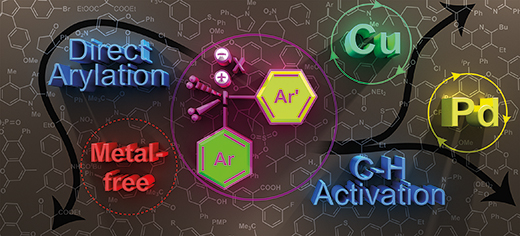Diaryliodonium Salts in Organic Syntheses: A Useful Compound Class for Novel Arylation Strategies, Klára Aradi, Balázs L. Tóth, Gergely L. Tolnai, Zoltán Novák, Synlett 2016, 27, 1456-1485. DOI: 10.1055/s-0035-1561369 | [Full Text Link]
Keywords: arylation - diaryliodonium salts - hypervalent iodine reagents - metal-free - copper-catalyzed - palladium-catalyzed - C–H activation - direct functionalization
This account aims to give a description of the usefulness of diaryliodonium salts in organic chemistry, including their synthesis and applications in the presence and absence of transition-metal catalysts. Herein, we briefly summarize the structural properties and reactivity of diaryliodonium salts. We describe several applications of these hypervalent reagents including metal-free arylations of C-, O-, N- and S-nucleophiles. The synthesis and functionalization of aromatic and heteroaromatic systems via copper- and palladium-catalyzed transformations are also discussed in this account.

Content:
1 Introduction
2 Structural Properties and Reactivity
3 Applications of Diaryliodonium Salts in Organic Syntheses
3.1 Transition-Metal-Free Arylations of Heteroatom and Carbon Nucleophiles
3.1.1 Arylation of Oxygen Nucleophiles
3.1.1.1 Arylation of (Hetero)aromatic Alcohols
3.1.1.2 Arylation of Aliphatic Alcohols
3.1.1.3 Arylation of Acids
3.1.2 Arylation of Nitrogen Nucleophiles
3.1.2.1 N-Arylation of Amines and Amides
3.1.2.2 N-Arylation of Heterocycles
3.1.3 Arylation of Sulfur Nucleophiles
3.1.4 Arylation of Inorganic Anions
3.1.5 Arylation of Carbon Nucleophiles
3.1.5.1 Electron-Rich Heterocycles
3.1.5.2 Arylation of Carbonyl and Nitro Compounds
3.2 Synthesis and Functionalization of Aromatic and Heteroaromatic Molecules with Diaryliodonium Salts in the Presence of Copper and Palladium Catalysts
3.2.1 C–H Functionalizations by Copper-Catalyzed C–H Arylations
3.2.2 Copper-Catalyzed Cyclization of Unsaturated Compounds with Diaryliodonium Salts
3.2.3 Palladium-Catalyzed Arylations
3.2.3.1 Electrophilic Palladation and Arylation
3.2.3.2 Directing-Group-Assisted C–H Bond Activation and Arylation
4 Conclusion
